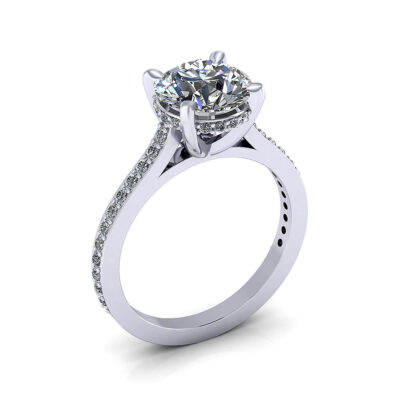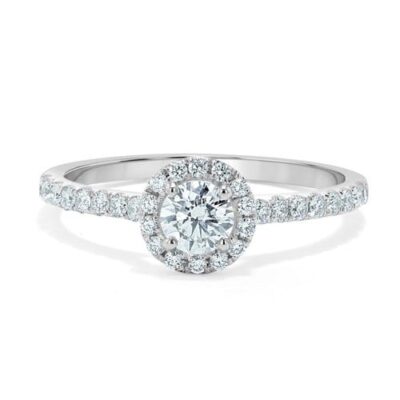Round Brilliant Cut Engagement Rings
The round brilliant cut is the most popular shape for a diamond engagement ring. Up to 75% of diamond rings feature round brilliant cuts, and this seems unlikely to change in the foreseeable future. If it has been well cut and polished, the round brilliant delivers unbeatable sparkle – something that never goes out of fashion.
Optimising Reflection And Refraction
The round brilliant cut diamond consists of 58 main facets: 33 on the crown (top half of the stone), and 25 on the pavilion (bottom half of the stone). Often,extra facets are added around the the girdle (the widest part of the diamond, where the crown meets the pavilion).
The pattern of facets was devised by Marcel Tolkowsky, a Belgian maths student whose family owned a diamond business. In 1919 Tolkowsky published his thesis, “Diamond Design: A Study of the Reflection and Refraction of Light in Diamond”. He had looked at the way that light is reflected within a diamond, and designed the round brilliant cut to optimise the combination of ‘fire’ (refraction of light into different colours) and brilliance (reflection of white light). A well made round brilliant cut diamond will also exhibit exceptional scintillation (sparkle), which jewellers call ‘life’.
Tightly Defined Proportions
Round diamonds existed before Tolkowsky’s innovation, but these ‘old cuts’ or ‘old European cuts’ were shaped differently to the round brilliant – they tended to be deeper, they generally had a smaller table facet, and an open culet (the tip at the bottom of the stone). Rather than work to a rigidly defined formula, a cutter was allowed some flexibility to maintain as much of the rough weight as they felt was sensible. Looking at old cuts, you can expect to see significant proportional variations.
Over the last few decades, many of these older diamonds have been re-cut to modern round brilliants. Unlike an old cut, the proportions of a modern round brilliant are tightly defined. If a stone deviates far from the theoretical ideal, it won’t score a high ‘cut grade’. For example, if a stone has been cut too deep or too shallow, light will tend to ‘leak’ out of the back of the stone, and it won’t sparkle as well as it should do. One area which is subject to some debate is the ideal width for the table facet (expressed as a percentage of the diamond’s width across the girdle, its widest point). A smaller table allows for more ‘fire’ or rainbow light, but comes at the cost of some ‘brilliance’ or return of white light. Tolkowsky was aware of this trade-off, and different opinions exist as to what exact table width produces the most aesthetically pleasing diamond. A side from this, there are very few areas where cutters are afforded significant latitude if they want to achieve an ‘Excellent’ or ‘Very Good’ cut grade.
Priced At A Premium To Other Diamond Shapes
Partly because rough diamonds tend to be octahedral in shape, and partly because of the limited scope to adapt the proportions of a round brilliant cut diamond, a diamond cutter would be doing well if he retains 50% of the rough weight in the finished stone. For this reason round brilliant cut diamonds tend to trade at a premium, sometimes costing 30% more than comparable diamonds in other shapes. In spite of this, there is never any shortage of demand!
Please feel free to get in touch if you have any questions, or to discuss commissioning your own bespoke design.


